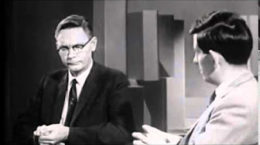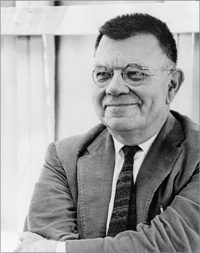by Charles Lear

For a brief period in the late 1960’s, UFO enthusiasts were encouraged by the fact that some scientists were beginning to take the subject seriously. This was due in large part to renowned atmospheric physicist Dr. James McDonald’s coming forward and publicly acknowledging that he was investigating the mystery. Around the same time, in 1966, Project Blue Book scientific consultant Dr. J. Allen Hynek angered many in the state of Michigan by offering the possibility that some of the UFOs reported during a flap that year in the state were swamp gas. This lead to a congressional hearing looking into the Air Force’s handling of the UFO problem, and that resulted in an Air Force funded scientific study at the University of Colorado headed by physicist Dr. Edward U. Condon. This was something many in the UFO community had been hoping for, and they were optimistic that something positive might come of it. Unfortunately, the project ran into personality problems that nearly derailed it.
An article written by John G. Fuller and published in the May 14, 1968, issue of Look Magazine looks deeply into the matter. Under the headline “Flying Saucer Fiasco,” the article is introduced as “The extraordinary story of the half-million-dollar ‘trick’ to make Americans believe the Condon committee was conducting an objective investigation.”
After giving an overview of the project and its participants, Fuller references a story published early October 1966, in the Denver Post. Project Coordinator Robert J. Low, describing the UFO project as a function of the university, was quoted as saying that it “comes pretty close to the criteria of non acceptability.”
According to Fuller, Condon was unable to spend much time in the project offices due to other responsibilities. Because of this, Low took on the majority of the decision- making. Then, on January 25, 1967, Condon made statements while speaking before a chapter of the honorary scientific fraternity, Sigma Xi, that strongly indicated he was biased. Fuller excerpts an article from the Elmira, New York, Star-Gazette:

“Unidentified flying objects are not the business of the Air Force,” … Dr. Edward U. Condon said here Wednesday night…. Dr. Condon left no doubt as to his personal sentiments on the matter: “It is my inclination right now to recommend that the Government get out of this business. My attitude right now is that there’s nothing to it.” With a smile, he added, “but I’m not supposed to reach a conclusion for another year…”
Responding to criticism, Condon said his comments were taken out of context.
All the files relating to the study and the university’s contract with the Air Force were open for perusal as part of an effort to avoid any accusations of secrecy or cover-up. A staff member, Roy Craig, was doing research for an upcoming speech at a teacher’s conference when he came upon a memo labeled “Some Thoughts on the UFO Project.” It was in a file labeled “AF Contract and Background,” and Craig had been referred to the file by Low.1 The memo was written by Low before the AF contract was signed and it contained these words:
Our study would be conducted almost exclusively by non-believers who, although they couldn’t possibly prove a negative result, could and probably would add an impressive body of evidence that there is no reality to the observations. The trick would be, I think, to describe the project so that, to the public, it would appear a totally objective study but, to the scientific community, would present the image of a group of nonbelievers trying their best to be objective, but having an almost zero expectation of finding a saucer.
Craig showed the memo to other staff members. All were particularly disturbed by Low’s use of the word, “trick,” and the memo became known as the “Trick Memo.” Disenchantment grew and many options were considered including: resigning en mass, issuing a press release, and putting out a minority report.
Hynek, McDonald, and staff members David Saunders, and Norman Levine held an informal meeting on Dec. 12, 1967, in Denver. There, they discussed the possibility of forming an organization consisting of professional-level individuals that would continue with a scientific investigation of UFOs, regardless of the Colorado Study’s conclusions.
After the meeting, McDonald learned about the Trick Memo and was shocked. Low phoned McDonald at the University of Arizona (McDonald had offered his services as a consultant) and McDonald expressed his concerns about the negative bias already being expressed by Low and Condon. Low hung up angrily and McDonald followed up with a letter listing his complaints. He called Low’s attention to the memo saying he was “puzzled by the viewpoints expressed there.”
Administrative Assistant Mary Louise Armstrong was present when Low read McDonald’s letter. She reported that he was extremely angered by it and that he felt that whoever gave a copy of the memo to McDonald should be immediately fired.
On February 7, Saunders was called to Condon’s office. Saunders was asked if he knew about the memo and where it was kept. Saunders responded by saying that the memo was only part of the problem. In his mind, the real problem was that the scientific integrity of the study was in jeopardy. Condon stayed with the subject of the memo. He was furious that he had not been told that McDonald knew about the memo and said, “For an act like that, you ought to be ruined professionally.”
While Saunders brought up that there was a gap between the views of Condon and Low and the rest of the staff, Levine was summoned to appear. Saunders offered to stay but was physically escorted out by Low as Levine was entering. Levine, disturbed by Saunder’s ejection, was also asked about the memo. As there was nothing confidential about the memo, Levine didn’t see that there was a problem with bringing it to McDonald’s attention. Condon asked why Levine hadn’t brought it to him and Levine replied that Condon’s public statements made it seem unlikely that there would be any effective communication.
Condon told Armstrong that he was going to fire both Saunders and Levine the next day. Armstrong had an impulse to resign, but she decided to confront Condon with the documentation showing the factors leading to the disagreements between him and his staff. She spoke with Condon on February 22, and pointed out that during her association with Low, she saw strong evidence that he was trying to say as little as possible in the report in the most negative way possible. Condon asked her to write him a follow-up letter and told her it would be unethical for her to disclose its contents to anyone else. Armstrong decided to go public and left the project.
Condon failed to respond to McDonald’s letter and McDonald brought the matter to the attention of the executive officers of the National Academy of Sciences (the organization that would be reviewing the results before their release to the public) in a written protest. Meanwhile, Saunders and Levine were dismissed, and the news of their dismissal spread throughout the UFO community and beyond. Condon refused to comment on the near mutiny of his staff, and Low said he would make “no comment” about Saunder’s and Levine’s dismissals.
In spite of the publicity shedding light on the bias of both Condon and Low, when the results of the study were released suggesting that UFOs were unworthy of scientific study, scientists who were starting to open their minds to the subject retreated back into the shadows. The UFOs didn’t and just a few years later there was a flap in 1973. That was also the year that Dr. J. Allen Hynek formed the Center for UFO Studies, an organization that was filled with scientists who knew how to play nice.
1Saunders, David R., Harkins, Roger R. UFOS? YES!–Where the Condon Committee Went Wrong. New York, New York: Signet, 1968.